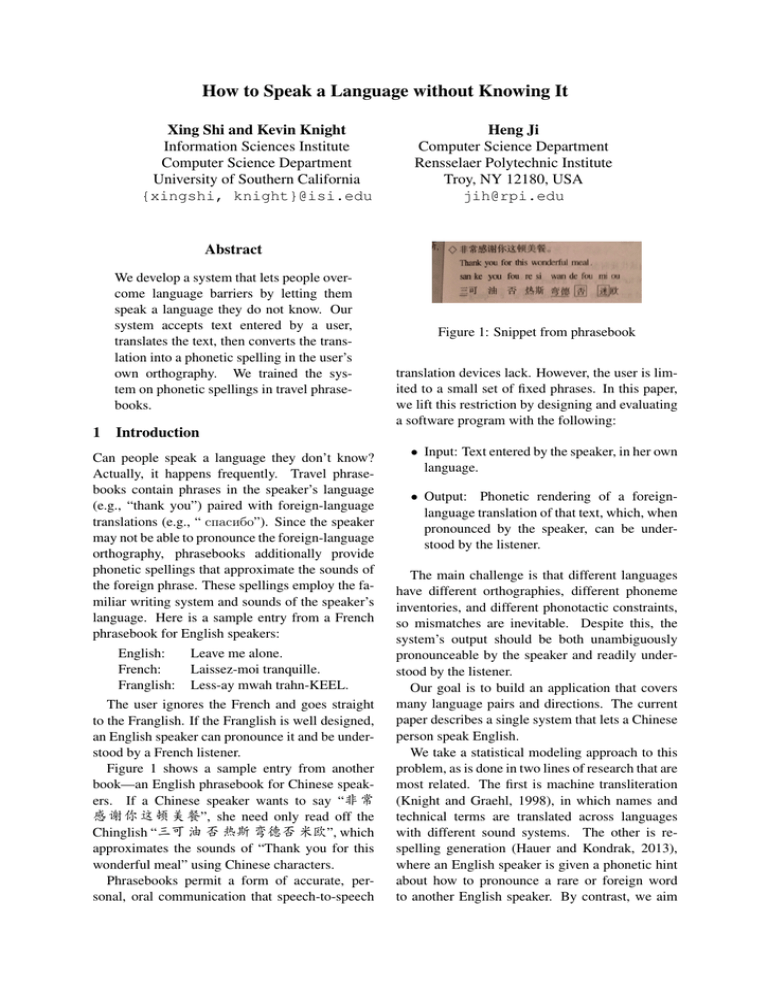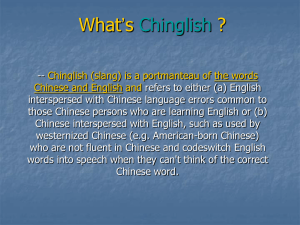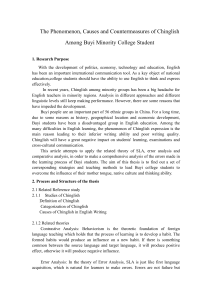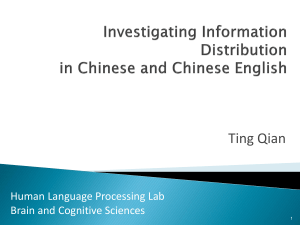How to Speak a Language without Knowing It
advertisement

How to Speak a Language without Knowing It
Xing Shi and Kevin Knight
Information Sciences Institute
Computer Science Department
University of Southern California
{xingshi, knight}@isi.edu
Heng Ji
Computer Science Department
Rensselaer Polytechnic Institute
Troy, NY 12180, USA
jih@rpi.edu
Abstract
We develop a system that lets people overcome language barriers by letting them
speak a language they do not know. Our
system accepts text entered by a user,
translates the text, then converts the translation into a phonetic spelling in the user’s
own orthography. We trained the system on phonetic spellings in travel phrasebooks.
1
Introduction
Can people speak a language they don’t know?
Actually, it happens frequently. Travel phrasebooks contain phrases in the speaker’s language
(e.g., “thank you”) paired with foreign-language
translations (e.g., “ спасибо”). Since the speaker
may not be able to pronounce the foreign-language
orthography, phrasebooks additionally provide
phonetic spellings that approximate the sounds of
the foreign phrase. These spellings employ the familiar writing system and sounds of the speaker’s
language. Here is a sample entry from a French
phrasebook for English speakers:
English:
Leave me alone.
French:
Laissez-moi tranquille.
Franglish: Less-ay mwah trahn-KEEL.
The user ignores the French and goes straight
to the Franglish. If the Franglish is well designed,
an English speaker can pronounce it and be understood by a French listener.
Figure 1 shows a sample entry from another
book—an English phrasebook for Chinese speakers. If a Chinese speaker wants to say “非 常
感 谢 你 这 顿 美 餐”, she need only read off the
Chinglish “三可 油 否 热斯 弯德否 米欧”, which
approximates the sounds of “Thank you for this
wonderful meal” using Chinese characters.
Phrasebooks permit a form of accurate, personal, oral communication that speech-to-speech
Figure 1: Snippet from phrasebook
translation devices lack. However, the user is limited to a small set of fixed phrases. In this paper,
we lift this restriction by designing and evaluating
a software program with the following:
• Input: Text entered by the speaker, in her own
language.
• Output: Phonetic rendering of a foreignlanguage translation of that text, which, when
pronounced by the speaker, can be understood by the listener.
The main challenge is that different languages
have different orthographies, different phoneme
inventories, and different phonotactic constraints,
so mismatches are inevitable. Despite this, the
system’s output should be both unambiguously
pronounceable by the speaker and readily understood by the listener.
Our goal is to build an application that covers
many language pairs and directions. The current
paper describes a single system that lets a Chinese
person speak English.
We take a statistical modeling approach to this
problem, as is done in two lines of research that are
most related. The first is machine transliteration
(Knight and Graehl, 1998), in which names and
technical terms are translated across languages
with different sound systems. The other is respelling generation (Hauer and Kondrak, 2013),
where an English speaker is given a phonetic hint
about how to pronounce a rare or foreign word
to another English speaker. By contrast, we aim
Chinese
English
Chinglish
Chinese
English
Chinglish
Chinese
English
Chinglish
已经八点了
It’s eight o’clock now
意思埃特额克劳克闹 (yi si ai te e ke lao ke nao)
这件衬衫又时髦又便宜
this shirt is very stylish and not very expensive
迪思舍特意思危锐思掉利失安的闹特危锐伊克思班西五
我们外送的最低金额是15美金
our minimum charge for delivery is fifteen dollars
奥儿米尼们差只佛低利沃锐意思发五听到乐思
Table 1: Examples of <Chinese, English, Chinglish> tuples from a phrasebook.
to help people issue full utterances that cross language barriers.
2
Evaluation
Our system’s input is Chinese. The output is
a string of Chinese characters that approximate
English sounds, which we call Chinglish. We
build several candidate Chinese-to-Chinglish systems and evaluate them as follows:
a great deal from Chinese (Table 2). Syllables “si”
and “te” are very popular, because while consonant clusters like English “st” are impossible to reproduce exactly, the particular vowels in “si” and
“te” are fortunately very weak.
Frequency Rank
1
2
3
4
5
• We compute the normalized edit distance
between the system’s output and a humangenerated Chinglish reference.
• A Chinese speaker pronounces the system’s
output out loud, and an English listener takes
dictation. We measure the normalized edit
distance against an English reference.
• We automate the previous evaluation by replace the two humans with: (1) a Chinese
speech synthesizer, and (2) a English speech
recognizer.
3
Chinese
de
shi
yi
ji
zhi
Chinglish
si
te
de
yi
fu
Table 2: Top 5 frequent syllables in Chinese
(McEnery and Xiao, 2004) and Chinglish
We find that multiple occurrences of an English
word type are generally associated with the same
Chinglish sequence. Also, Chinglish characters do
not generally span multiple English words. It is
reasonable for “can I” to be rendered as “kan nai”,
with “nai” spanning both English words, but this
is rare.
Data
We seek to imitate phonetic transformations found
in phrasebooks, so phrasebooks themselves are a
good source of training data. We obtained a collection of 1312 <Chinese, English, Chinglish>
phrasebook tuples 1 (see Table 1).
We use 1182 utterances for training, 65 for development, and 65 for test. We know of no other
computational work on this type of corpus.
Our Chinglish has interesting gross empirical
properties. First, because Chinglish and Chinese
are written with the same characters, they render
the same inventory of 416 distinct syllables. However, the distribution of Chinglish syllables differs
1
Dataset can be found at http://www.isi.edu/
natural-language/mt/chinglish-data.txt
4
Model
We model Chinese-to-Chinglish translation with
a cascade of weighted finite-state transducers
(wFST), shown in Figure 2. We use an online
MT system to convert Chinese to an English word
sequence (Eword), which is then passed through
FST A to generate an English sound sequence
(Epron). FST A is constructed from the CMU Pronouncing Dictionary (Weide, 2007).
Next, wFST B translates English sounds into
Chinese sounds (Pinyin-split). Pinyin is an official
syllable-based romanization of Mandarin Chinese
characters, and Pinyin-split is a standard separation of Pinyin syllables into initial and final parts.
Our wFST allows one English sound token to map
labeled Epron
d
ao r
P (p|e)
0.46
0.40
0.06
0.01
0.26
0.13
0.06
0.01
Pinyin-split
d
de
di
s
u
o
ao
ou
Table 3: Learned translation tables for the
phoneme based model
g
r ae n d
m
ah dh er
g e r an
de mu e
d
e
where as the reference Pinyin-split sequence is:
Figure 2: Finite-state cascade for modeling the relation between Chinese and Chinglish.
to one or two Pinyin-split tokens, and it also allows
two English sounds to map to one Pinyin-split token.
Finally, FST C converts Pinyin-split into Pinyin,
and FST D chooses Chinglish characters. We also
experiment with an additional wFST E that translates English words directly into Chinglish.
5
Training
FSTs A, C, and D are unweighted, and remain so
throughout this paper.
5.1
Phoneme-based model
We must now estimate the values of FST B parameters, such as P(si|S). To do this, we first
take our phrasebook triples and construct sample
string pairs <Epron, Pinyin-split> by pronouncing the phrasebook English with FST A, and by
pronouncing the phrasebook Chinglish with FSTs
D and C. Then we run the EM algorithm to learn
FST B parameters (Table 3) and Viterbi alignments, such as:
g
ge
5.2
r
r
ae n
uan
d
de
Phoneme-phrase-based model
Mappings between phonemes are contextsensitive. For example, when we decode English
“grandmother”, we get:
g
e
r
uan
d
e
m
a
d
e
Here, “ae n” should be decoded as “uan” when
preceded by “r”. Following phrase-based methods in statistical machine translation (Koehn et
al., 2003) and machine transliteration (Finch and
Sumita, 2008), we model substitution of longer sequences. First, we obtain Viterbi alignments using
the phoneme-based model, e.g.:
g
ge
r
r
ae n
uan
d
de
m
m
ah
a
dh
d
er
e
Second, we extract phoneme phrase pairs consistent with these alignments. We use no phrasesize limit, but we do not cross word boundaries.
From the example above, we pull out phrase pairs
like:
g→g e
g r→g e r
...
r→r
r ae n → r uan
...
We add these phrase pairs to FST B, and call
this the phoneme-phrase-based model.
5.3
Word-based model
We now turn to WFST E, which short-cuts directly from English words to Pinyin. We create
<English, Pinyin> training pairs from our phrasebook simply by pronouncing the Chinglish with
FST D. We initially allow each English word type
to map to any sequence of Pinyin, up to length 7,
with uniform probability. EM learns values for parameters like P (nai te|night), plus Viterbi alignments such as:
Model
Word based
Word-based hybrid training
Phoneme based
Phoneme-phrase based
Hybrid training and decoding
Top-1 Overall
Average Edit Distance
0.664
0.659
0.611
0.194
0.175
Top-1 Valid
Average Edit Distance
0.042
0.029
0.583
0.136
0.115
Coverage
29/65
29/65
63/65
63/65
63/65
Table 4: English-to-Pinyin decoding accuracy on a test set of 65 utterances. Numbers are average edit
distances between system output and Pinyin references. Valid average edit distance is calculated based
only on valid outputs (e.g. 29 outputs for word based model).
accept
a ke sha pu
tips
te ti pu si
Notice that this model makes alignment errors
due to sparser data (e.g., the word “tips” and “ti pu
si” only appear once each in the training data).
5.4
Hybrid training
To improve the accuracy of word-based EM alignment, we use the phoneme based model to decode each English word in the training data to
Pinyin. From the 100-best list of decodings, we
collect combinations of start/end Pinyin syllables
for the word. We then modify the initial, uniform
English-to-Pinyin mapping probabilities by giving
higher initial weight to mappings that respect observed start/end pairs. When we run EM, we find
that alignment errors for “tips” in section 5.3 are
fixed:
accept
a ke sha pu te
5.5
tips
ti pu si
Word Type
Token
Unseen
62
62
Total
249
436
Ratio
0.249
0.142
Table 6: Unseen English word type and tokens in
test data.
Hybrid decoding
The word-based model can only decode 29 of the
65 test utterances, because wFST E fails if an utterance contains a new English word type, previously unseen in training. The phoneme-based
models are more robust, able to decode 63 of the
65 utterances, failing only when some English
word type falls outside the CMU pronouncing dictionary (FST A).
Our final model combines these two, using the
word-based model for known English words, and
the phoneme-based models for unknown English
words.
6
the test portion of our phrasebook, using edit distance. Here, we start with reference English and
measure the accuracy of Pinyin syllable production, since the choice of Chinglish character does
not affect the Chinglish pronunciation. We see that
the Word-based method has very high accuracy,
but low coverage. Our best system uses the Hybrid training/decoding method. As Table 6 shows,
the ratio of unseen English word tokens is small,
thus large portion of tokens are transformed using word-based method. The average edit distance of phoneme-phrase model and that of hybrid training/decoding model are close, indicating
that long phoneme-phrase pairs can emulate wordpinyin mappings.
Experiments
Our first evaluation (Table 4) is intrinsic, measuring our Chinglish output against references from
Model
Reference English
Phoneme based
Hybrid training and decoding
Valid Average
Edit Distance
0.477
0.696
0.496
Table 7: Chinglish-to-English accuracy in dictation task.
Our second evaluation is a dictation task. We
speak our Chinglish character sequence output
aloud and ask an English monolingual person to
transcribe it. (Actually, we use a Chinese synthesizer to remove bias.) Then we measure edit distance between the human transcription and the reference English from our phrasebook. Results are
shown in Table 7.
Chinese
Reference English
Reference Chinglish
Hybrid training/decoding Chinglish
Dictation English
ASR English
Chinese
Reference English
Reference Chinglish
Hybrid training/decoding Chinglish
Dictation English
ASR English
年夜饭都要吃些什么
what do you have for the Reunion dinner
沃特 杜 又 海夫 佛 则 锐又尼恩 低呢
我忒 度 优 嗨佛 佛 得 瑞优你恩 低呢
what do you have for the reunion dinner
what do you high for 43 Union Cena
等等我
wait for me
唯特 佛 密 (wei te fo mi)
位忒 佛 密 (wei te fo mi)
wait for me
wait for me
Table 5: Chinglish generated by hybrid training and decoding method and corresponding recognized
English by dictation and automatic synthesis-recognition method.
Model
Word based
Word-based hybrid training
Phoneme based
Phoneme-phrase based
Hybrid training and decoding
Valid Average
Edit Distance
0.925
0.925
0.937
0.896
0.898
Table 8: Chinglish-to-English accuracy in automatic synthesis-recognition (ASR) task. Numbers
are average edit distance between recognized English and reference English.
Finally, we repeat the last experiment, but removing the human from the loop, using both
automatic Chinese speech synthesis and English
speech recognition. Results are shown in Table 8.
Speech recognition is more fragile than human
transcription, so edit distances are greater. Table 5
shows a few examples of the Chinglish generated
by the hybrid training and decoding method, as
well as the recognized English from the dictation
and ASR tasks.
7
Conclusions
Our work aims to help people speak foreign languages they don’t know, by providing native phonetic spellings that approximate the sounds of foreign phrases. We use a cascade of finite-state
transducers to accomplish the task. We improve
the model by adding phrases, word boundary constraints, and improved alignment.
In the future, we plan to cover more language
pairs and directions. Each target language raises
interesting new challenges that come from its natural constraints on allowed phonemes, syllables,
words, and orthography.
References
Andrew Finch and Eiichiro Sumita. 2008. Phrasebased machine transliteration. In Proceedings of the
Workshop on Technologies and Corpora for AsiaPacific Speech Translation (TCAST), pages 13–18.
Bradley Hauer and Grzegorz Kondrak. 2013. Automatic generation of English respellings. In Proceedings of NAACL-HLT, pages 634–643.
Kevin Knight and Jonathan Graehl. 1998. Machine transliteration. Computational Linguistics,
24(4):599–612.
Philipp Koehn, Franz Josef Och, and Daniel Marcu.
2003. Statistical phrase-based translation. In
Proceedings of the 2003 Conference of the North
American Chapter of the Association for Computational Linguistics on Human Language TechnologyVolume 1, pages 48–54. Association for Computational Linguistics.
Anthony McEnery and Zhonghua Xiao. 2004. The
lancaster corpus of Mandarin Chinese: A corpus for
monolingual and contrastive language study. Religion, 17:3–4.
R Weide. 2007. The CMU pronunciation dictionary,
release 0.7a.





